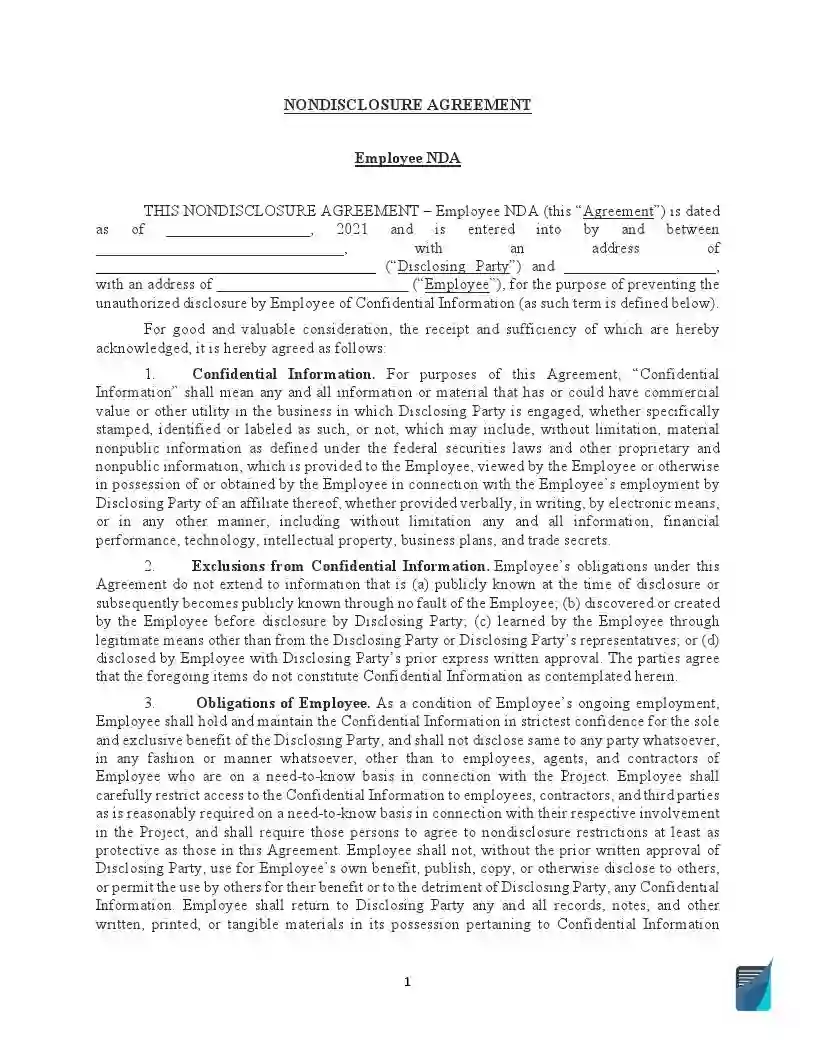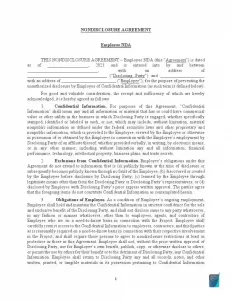Employee Non-Disclosure Agreement
An employee non-disclosure agreement is a legally-binding contract that restricts what information the signing parties can share. It can also be titled as a confidentiality agreement, a proprietary information agreement, or simply an NDA.
Non-disclosure agreements are used to protect confidential information, trade secrets, and even customer lists. Almost any company information that the company wants to protect can be protected with an NDA agreement. Many industries work with information that they want to keep secret from competitors or the public.
NDAs can be common practice among many industries and professionals. Before drafting or signing one, you will want to be sure that you understand what a non-disclosure agreement covers and what it does not.
Though NDAs are a standard practice among many companies, there can still be some confusion about what they cover and don’t. If you are dealing with a non disclosure agreement template, either through drafting or signing one, you will want to know exactly what to expect an NDA to protect.

Build Your Document
Answer a few simple questions to make your document in minutes
Save and Print
Save progress and finish on any device, download and print anytime
Sign and Use
Your valid, lawyer-approved document is ready
When to Use an Employee Non-Disclosure Agreement
A company can use an employee non-disclosure agreement with an employee when sensitive information needs to be protected. Companies can use a non-disclosure agreement to protect confidential information, trade secrets, and customer lists. Having an employee sign this agreement helps ensure that company information stays protected.
An employee non-disclosure agreement can also set expectations about what happens when the agreement is broken. When an employee signs a non-disclosure agreement, they should know what can happen when they share information that is protected.
A non-disclosure agreement makes it easier for both parties to understand what can and cannot be shared. As new business developments are made, an NDA will define those terms and indicate when information can be shared or made public to protect the business.
What Are the Risks of Not Using an Employee NDA?
When a company chooses not to use an employee non-disclosure agreement, they run into problems in protecting company information. Though establishing a non-disclosure agreement may seem like you don’t trust employees, having one will keep relationships strong and with boundaries.
With a non-disclosure agreement, a company can protect its intellectual property and money can be lost. With an agreement that lays out what is protected and cannot be shared, a company can continue to use its intellectual property without the risk of it getting to competitors.
Much of business is run successfully by sharing the right information at the right time. After an employee signs a non-disclosure agreement, they cannot share company information without the right consent. This will prevent employees from sharing information more freely and help keep business relations strong.
Without an agreement for confidential information, a company may have to undergo more litigation and time to protect company information to protect them. An agreement sets boundaries and makes it clear what can be shared and when making potential legal problems easier to navigate.
What to Include in an Employee NDA
When determining what to include in an employee non-disclosure agreement, a company will have to decide what trade secrets and company information it wants to protect. Businesses have a lot of information that they will want to protect to be successful and a non-disclosure agreement should cover all of that confidential information.
Non-disclosure agreements also protect clients. Customer lists can also be included to keep them safe as well. It is also an important consideration for other companies to not have a customer list.
An agreement will also cover exceptions and exclusions to confidential information. This also covers if a court finds an aspect of the agreement unenforceable and negates that part of the contract.

Filling Out the Employee NDA
There are several aspects to an employee non-disclosure agreement that should be understood before the parties sign the agreement.
Confidential Information
This aspect of the agreement defines confidential information and what company information is protected by the agreement. This information can include but is not limited to, trade secrets and customer lists. Company information that the company wants to restrict access to is included in this section.
Exclusions from Confidential Information
This section of the agreement lays out the exclusions to confidential information. These exceptions include information that is publicly known, known by the employee before the company disclosed it, what was learned from the employee through other means, and what is revealed with company permission.
Obligations of Employee
This section covers what the expectations of the employee are with regards to company information. This may also require employees to have other people sign non-disclosure agreements when necessary.
Time Periods
This section of the agreement covers how long the agreement will last. In some cases, trade secrets can never be shared. In other cases, the contract is over at a specified date.
Relationship
This section of the agreement covers defining the relationship between the two parties, either as employee and employer or an independent contractor.
Severability
This section of the agreement covers what will happen if the contract is deemed invalid or unenforceable by a court. NDAs can be made void due to vagueness or confusion about what it covers. When drafting an NDA, you will want to cover all the terms and conditions that the NDA applies to without infringing on other rights.
Integration
This aspect of the contract covers how this contract applies to other contracts that the parties have signed. It also establishes how the agreement will be amended.
Waiver
This part of the agreement establishes that signing this contract is not waiving any prior rights of the employee.
Binding Effect
This section covers how binding the contract is and who else may be impacted.
Enforcement of Rights
This section covers what the employee will need to do in the event of a breach of contract. This can include paying fines or covering legal fees for the disclosing party.
Choice of Law
This section covers the state that the contract is enforceable. Every state has unique laws about employee non-disclosure agreements and before drafting or signing one you should be familiar with what is enforceable.
Indemnification
This section of the agreement covers that the employee agrees to cover any losses or damages. This section can be enforceable after the non-disclosure agreement expires.
Signing
Both the employee and the disclosing party sign the contract, with dates and witnesses. Once the contract is signed, it is enforceable.
Frequently Asked Questions
What is the Defend Trade Secrets Act?
The Defend Trade Secrets Act is a federal law that standardized the definition of trade secrets. It also establishes the consequences for someone misappropriating or stealing a trade secret.
With the passing of this act, the definition of trade secrets became uniform to cover tangible and intangible company data and information. To be a trade secret, the object or procedure must be business-related that gives the company a competitive edge. This definition is still vague but it does set boundaries as to what is expected to be a trade secret and what is not covered.
It also must increase the overall value of the current market. A good example of a trade secret is Coca-cola’s secret recipe because it is not publicly known and gives the company a competitive edge. Any company secret that is not publicly known is a trade secret and can be covered by an NDA.
This act also covers the definition of misappropriation. Misappropriation is when a trade secret has been obtained through improper or illegal means. When this happens, a lawyer can be used to find a remedy.
Can an employer demand their employee sign an NDA?
Requiring an employee to sign an NDA is a standard practice among many industries and businesses. Often, a company doesn’t run into problems when asking an employee to sign an employee non-disclosure agreement. With most contracts, three elements have to be met; the offer, the acceptance, and consideration. Consideration is what makes the contract value to an employee to sign.
Depending on the state that you’re in, a company does have options to get an employee to sign an NDA. For new employees, the consideration to work at that company is the consideration of value for signing the contract.
With existing employees, the consideration for signing an NDA may have to be more thought out. This can come in the form of a pay rise or another incentive. The consideration has to be new in many instances.
Can an Employee Negotiate the Terms of the NDA?
As with any contract, the person signing it wants to know what they are agreeing to. With any non-disclosure agreement, expect the employee to read the contract and have questions. Some employees may even want to negotiate the agreement.
Employees can ask to negotiate the NDA but the company does not have to be receptive. Negotiating an NDA can be useful when defining the skills that an employee has and if that skill is already well-known in the industry. Employees will also want to define what they already know in the event of a breach.